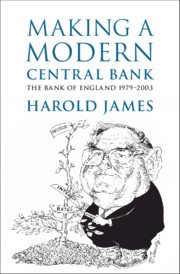Book contents
- Making a Modern Central Bank
- Studies in Macroeconomic History
- Making a Modern Central Bank
- Copyright page
- Dedication
- Contents
- Figures
- Tables
- Acknowledgements
- Abbreviations
- 1 Introductory
- 2 Foreign Fetters
- 3 The Performance of the UK Economy
- 4 The Inexplicable in Pursuit of the Uncontrollable
- 5 ‘A Good Deal of Advice’
- 6 The Long Shadow of the Deutschemark
- 7 Hong Kong
- 8 Shaved Eyebrows
- 9 Tunnelling Deep
- 10 Great Leap in the Dark
- 11 The Spine Theory and Its Collapse
- 12 ‘You Can’t Be In and Out at the Same Time’:
- 13 Horses for Courses
- 14 Failure of Internal Communication
- 15 The New Bank
- 16 Epilogue
- Book part
- Notes
- Bibliography
- Index
1 - Introductory
Published online by Cambridge University Press: 18 September 2020
- Making a Modern Central Bank
- Studies in Macroeconomic History
- Making a Modern Central Bank
- Copyright page
- Dedication
- Contents
- Figures
- Tables
- Acknowledgements
- Abbreviations
- 1 Introductory
- 2 Foreign Fetters
- 3 The Performance of the UK Economy
- 4 The Inexplicable in Pursuit of the Uncontrollable
- 5 ‘A Good Deal of Advice’
- 6 The Long Shadow of the Deutschemark
- 7 Hong Kong
- 8 Shaved Eyebrows
- 9 Tunnelling Deep
- 10 Great Leap in the Dark
- 11 The Spine Theory and Its Collapse
- 12 ‘You Can’t Be In and Out at the Same Time’:
- 13 Horses for Courses
- 14 Failure of Internal Communication
- 15 The New Bank
- 16 Epilogue
- Book part
- Notes
- Bibliography
- Index
Summary
This introductory chapter outlines the transformation or modernization of the Bank of England in the twenty years after 1979: how governance and accountability were transformed, and communication was accorded a greater role, as the Bank moved to policy autonomy or operational independence from the UK government. The process amounted to what might be described as an informational revolution. The transformation of macro-economic management may also be considered as part of a broader process of globalization. Central banks everywhere became much more aware of international activities and developments, and policy-makers reflected more on how the UK was affected by what went on beyond its frontiers. There was also a greater legalization: a need for legislation to define what was involved in banking, and how to regulate banking. Finally, the nature and definition of money and of monetary stability became the subject of a political debate.
Keywords
- Type
- Chapter
- Information
- Making a Modern Central BankThe Bank of England 1979–2003, pp. 1 - 31Publisher: Cambridge University PressPrint publication year: 2020

